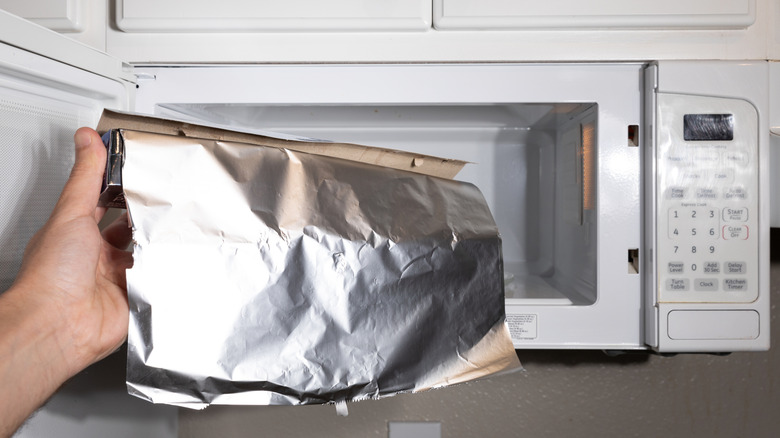Why Does Aluminum Foil Spark When You Put It In A Microwave But Not An Oven?
You've probably heard that you shouldn't put metal objects like aluminum foil or silverware in the microwave, or perhaps you've been unfortunate enough yourself to try reheating a foil-wrapped burrito only to witness your microwave fill with flying sparks. These sparks aren't just a pretty light show, they can ignite other materials in the microwave like paper towels or wax paper. Seems like pretty dangerous stuff to have around, but then why is it fine to use aluminum foil and aluminum trays to heat foods up in the oven?
In order to explain why the dangers of aluminum foil apply to microwaves but not ovens, you need to understand how microwaves work, which requires some explanation. Unlike an oven, a microwave doesn't actually get hot. Instead, microwaves use a device called a magnetron, which generates a variety of electromagnetic waves called, you guessed it, microwaves. Water, fat, and sugar are all capable of absorbing microwaves, which causes foods to get hot when you expose them to microwave radiation.
Metals like aluminum have a very different reaction to microwaves, which agitate electrons within the metal, causing a charge to build up. As more electrons amass, the charge can become so intense that electrons are torn from their molecules, creating ions. This reaction causes a spark, which can ignite a fire in some cases, making it extremely dangerous to microwave metal. But there are some very specific exceptions to this danger.
Why microwaves are made of metal
You've probably been warned against putting aluminum foil or any other kind of metal in the microwave, and yet, we use other forms of metal in the microwave all the time. Hot Pockets famously used to come in a metal-lined pouch for heating, and many microwave ovens come with a metal rack in them, which is perfectly safe to use. The mesh on the inside of your microwave door is metal, and in fact, so is the entire microwave chamber. It's all a big metal box, so why doesn't it explode in a flurry of sparks every time you use it?
Generally speaking, metals are safe to go in the microwave if they are relatively thick, and most importantly, smooth. The flat walls of a microwave oven reflect the microwaves themselves, directing them towards your food rather than allowing them to escape the chamber, and the lining of a Hot Pocket sleeve served a similar purpose.
The problem with aluminum foil, especially when it's been crinkled and wrapped around food, is that it has thin, pointy edges. The same goes for forks and knives. Whereas agitated electrons can flow freely around smooth, flat surfaces, they get stuck if they run into a sharp dead end, like a crinkle in foil or the tine of a fork. As more electrons accumulate in these dead-end zones, they build up a negative charge until electrons start flying off in a sparkling, crackling nightmare.

